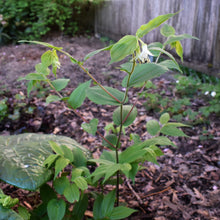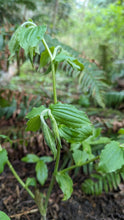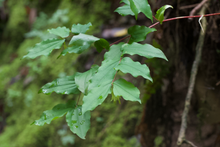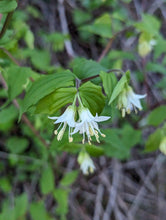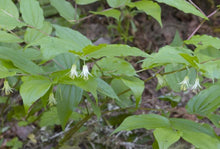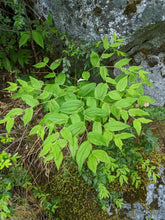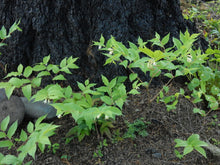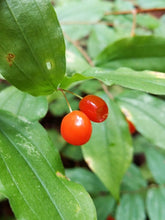
Prosartes hookeri (syn Disporum hookeri)
Hooker's fairybells is a gorgeous shade-loving perennial that is truly enchanting in a woodland garden - especially when planted in groups or drifts. In spring, its intricate white flowers generally bloom in pairs from branch tips, the petals flaring outward to reveal dangling yellow anthers. The graceful branching pattern of its stems and leathery leaves are quite architectural, and hold their artful form even in the peak of the summer drought. As the growing season wraps up, the flowers mature into shiny orange fruits, a color as noteworthy as it is uncommon in any native garden.
- Plant type/canopy layer: deciduous, perennial, herbaceous plant
- Size at maturity: 12-36" tall, 12-24" wide
- Light requirements: full shade, part sun/part shade
- Moisture requirements: moist soil
- Bloom Time: April - July
- Growth rate/ease: fast growing, easy to grow
- Wildlife support: flowers attract and support hummingbirds; overall plant attracts bees and other insect pollinators
- Native habitat/range: common in shady damp thickets, montane conifer and mixed-evergreen forests, and exposed roadsides, from sea level to about 2300m, from Alberta and British Columbia to California and east to Montana. Additional populations have been found in the Black Hills of Wyoming and South Dakota as well as in the Porcupine Mountains in Michigan. In Oregon, it generally occurs in the western portion of the state and the Umatilla Forest. Portland Plant List - yes.
- Special features & uses: attracts hummingbirds; technically edible, though bland and mealy and generally considered best left for wildlife and propagation
Gardening with Hooker’s Fairybells: This cheerful, drought-tolerant wildflower is ideal for shady woodland gardens. It requires soil with lots of organic matter. Try integrating compost initially, if needed, and leaving the fall leaves and other debris where they fall each year. It grows taller with a robust stature, gorgeous when interplanted throughout the middle of shady beds where it can strike a pose above lower-growing groundcovers.
Companion Plants: Try this beauty in the shade of native trees such as big leaf or vine maples (Acer macrophyllum/circinatum), quaking aspen (Populus tremuloides) or Douglas fir (Pseudotsuga menziesii); shrubs such as salal (Gaultheria shallon), osoberry (Oemleria cerasiformis), snowberry (Symphoricarpos albus), oval-leaved viburnum (Viburnum ellipticum) or Pacific ninebark (Physocarpus capitatus) and herbaceous plant like candyflower (Claytonia sibirica), Pacific waterleaf (Hydrophyllum tenuipes), Oxalis (Oxalis oregana), violets (Viola sp.) and of course any and all types of ferns.
Photo Credit 1 & 5: Nikkie West, Sparrowhawk Native Plants
Photo Credit 2 (early spring): © Jan Smith, some rights reserved (CC-BY)
Photo Credit 3 (foliage): © Arvel Hernandez, some rights reserved (CC-BY)
Photo Credit 4 (flowers close): © Dominic Gentilcore, some rights reserved (CC-BY)
Photo Credit 6 (from above): © Kayla Sweeten, some rights reserved (CC-BY)
Photo Credit 7 (flowering habit): © Ed Alverson, some rights reserved (CC-BY)
Photo Credit 8 (fruits): © Chloe and Trevor Van Loon, some rights reserved (CC-BY)








